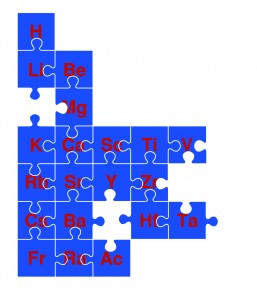THURSDAY, 1 OCTOBER 2009
No chemistry textbook or laboratory wall would be complete without a prominently placed periodic table. This seemingly simple arrangement contains information about the atomic elements and is the culmination of the work of many scientists over more than a century. The table’s discovery is usually attributed to Dmitri Mendeleev, but he was not the only one to puzzle over the periodicity of the elements, nor the first to look for a way of arranging them. Indeed, Mendeleev’s table bears only a passing resemblance to the current form as subsequent discoveries have initiated changes.The periodic table contains over 100 elements, 92 naturally occurring, the others produced in nuclear reactors or particle accelerators. The elements are listed in ascending order of atomic number, that is the number of protons contained in a single atom, but arranged ‘periodically’ with elements of the same valence (describing their bonding power), which exhibit similar properties, being grouped together.
The first accepted periodic table was developed before the configuration of the atom was known; so how did we arrive at this design? It began with the concept of an element – a substance that cannot be broken down into any simpler substances by chemical reaction. Aristotle believed there were just four: earth, air, fire and water, but this idea was surpassed when the first chemical element was recognised.
Many of what we would now call elements, were known from pre-history. We cannot know who first used gold for ornamentation, or who ushered in the Iron Age by identifying iron. We do know that German alchemist Hennig Brand was the first to discover an element by experimentation in 1649. Whilst searching for the Philosopher’s Stone, a mythical object that would turn other metals to gold, he instead isolated phosphorus.
During the next 200 years, a vast body of knowledge concerning the elements was acquired and by 1869 a total of 63 had been discovered. Scientists began to recognise patterns in the physical and chemical properties that the elements displayed. The atomic weight of the element (how heavy its atoms are in comparison to an atom of hydrogen, the lightest element) came to have particular significance.
The German chemist Johann Döbereiner noticed that strontium’s atomic weight (88) lies midway between those of calcium (40) and barium (137); elements that possess similar properties such as high reactivity with air and hydrogen gas production on contact with water. In 1829 after discovering two further groupings: the alkali metals lithium, sodium and potassium and the halogens chlorine, bromine and iodine, he proposed that nature exists in triads, with the properties of the middle element being an average of the other two - the Law of Triads.
Scientists soon found that group extended beyond triads and began to look for ways to arrange the elements. Lexandre-Emile Béguyer de Chancourtois, a French geology professor, used their atomic weights to plot the elements as a continuous spiral around a cylinder. His ‘telluric screw’ had some success in lining up elements of similar properties but on publication in 1862 his contemporaries found it difficult to understand. Scientists in other countries only became aware of his work years later.
One year later English chemist John Newlands noticed that when arranged in order of increasing atomic weight, elements separated in the list by an interval of eight had similar properties. Comparing this trend with the octaves of music, he referred to it as the Law of Octaves. However, this law broke down for elements with atomic weights higher than that of calcium and when presented to the Chemical Society (one of the forerunners to the Royal Society of Chemistry) his work was criticised and his contribution was not recognised for another two decades.
Building on the foundations of these scientists, the competition came down to two men: German chemist Julius Lothar Meyer and Russian chemistry professor Dmitri Ivanovich Mendeleev. Both men produced remarkably similar results at the same time, while working independently of one another.
Meyer constructed a table listing elements in increasing weight order, with those of the same valence appearing in the same column. The periodic nature of the elements was clearly demonstrated by plotting a graph of atomic volume against atomic weight. Unfortunately for Meyer, when he published his table in 1870 it was a year too late. Available to the scientific community since 1869, Mendeleev’s table claimed priority, leaving Meyer’s to only confirm the discovery.
Mendeleev’s table listed the elements in the same arrangement but with some superior features. Knowing atomic weights were not always accurate, he placed certain elements out of order to preserve group properties. As more accurate weights became available, his order proved to be correct. He had such confidence, that he used his table to predict the properties of missing elements and was proved correct with gallium, germanium and scandium all discovered within his lifetime.
One thing Mendeleev did not foresee was the existence of a whole new group of elements; the noble gases. Sir William Ramsey and Lord Rayleigh published their discovery of argon in 1895. There was no space in the periodic table for this new element, but after Ramsey went on to discover neon, krypton and xenon, group ‘zero’ was added to the table, so-called due to the zero valencies of the elements.
Mendeleev’s table was still not quite perfect. 1914 English physicist Henry Mosley determined the number of protons in an atom of each element by bombarding them with X-rays. Arranging the elements in order of increasing atomic number rather than atomic weight, he eliminated the remaining inconsistencies.
The last major changes to the periodic table resulted from the work of Glenn Seaborg. Beginning with plutonium in 1940, he discovered all the transuranic elements from 94 to 102 through neutron bombardment of uranium. Element 106 is named seaborgium in his honour. Bombardment experiments continue to produce new elements; in June 2009 the heavy element 112 was officially recognised and will most-likely appear with the name ‘copernicium’ after the astronomer Copernicus. The German team who made the discovery already have their sights on finding element 120.
Thus we arrive at the modern periodic table. The elements are the building blocks of matter and knowledge of them is fundamental to understanding everything from the stars and planets to life on Earth. The periodic table represents a complete map of the elements and is an indispensable guide to the universe around us.
Lindsey Nield is a PhD student in the Department of Physics



